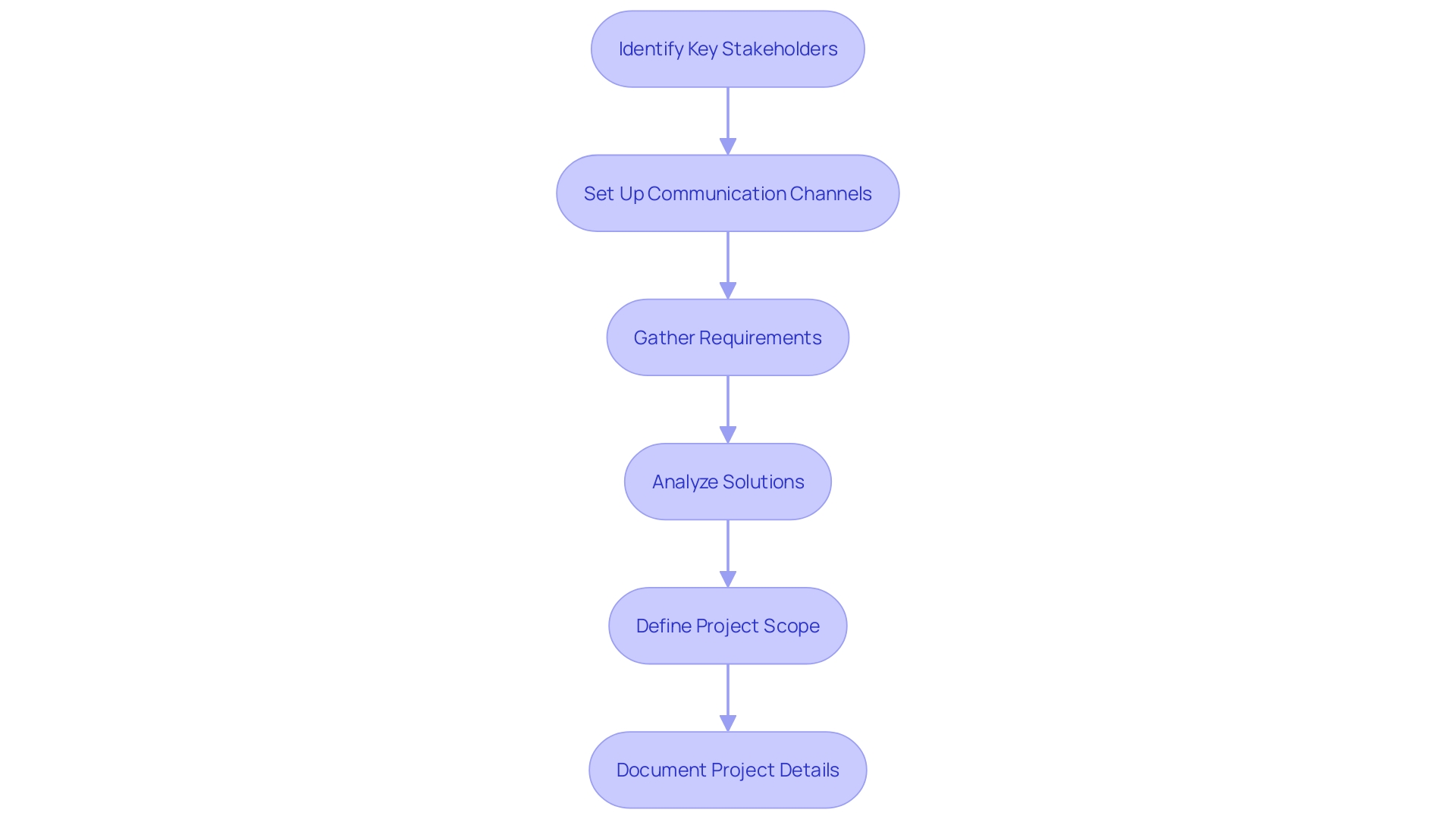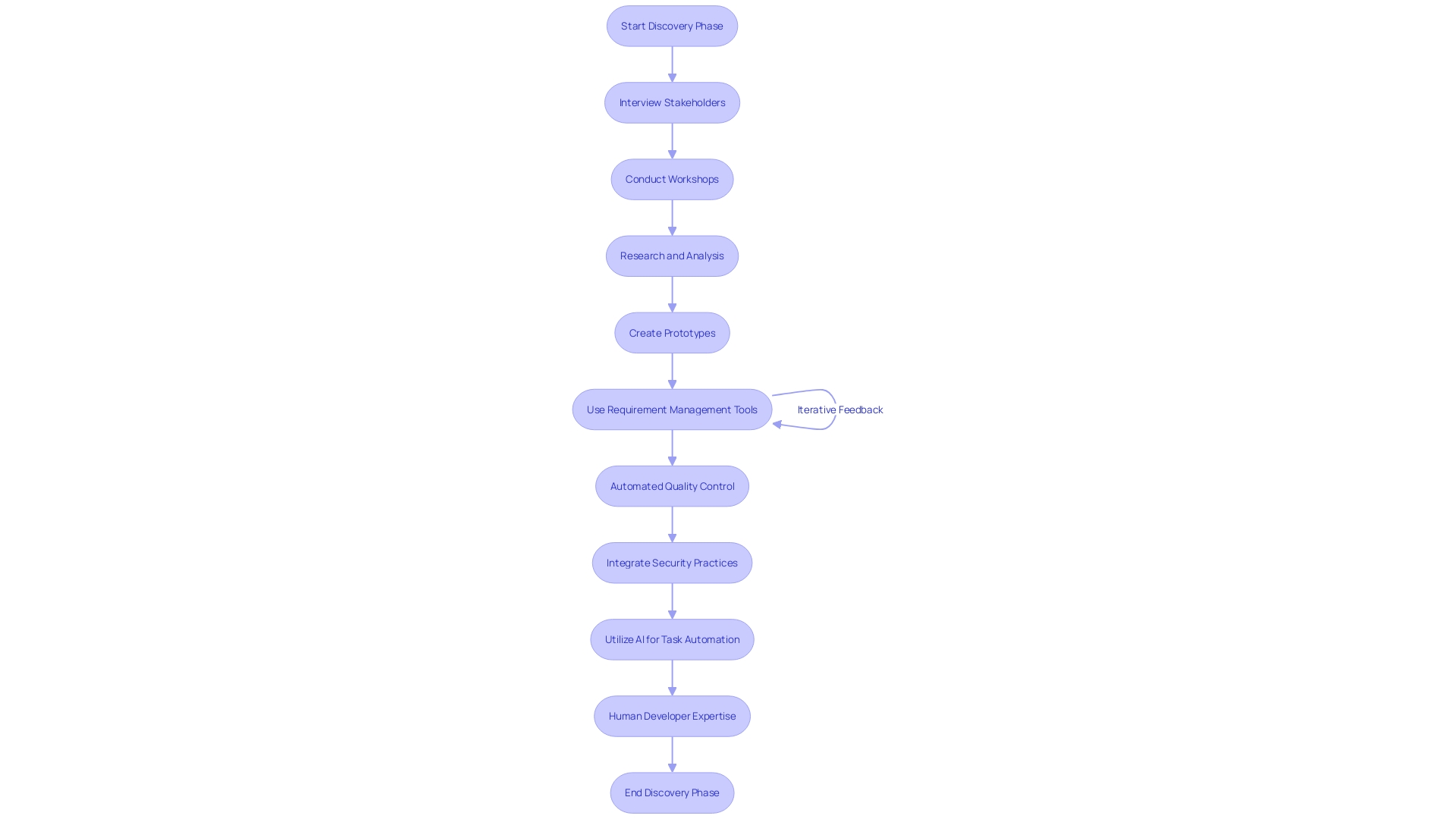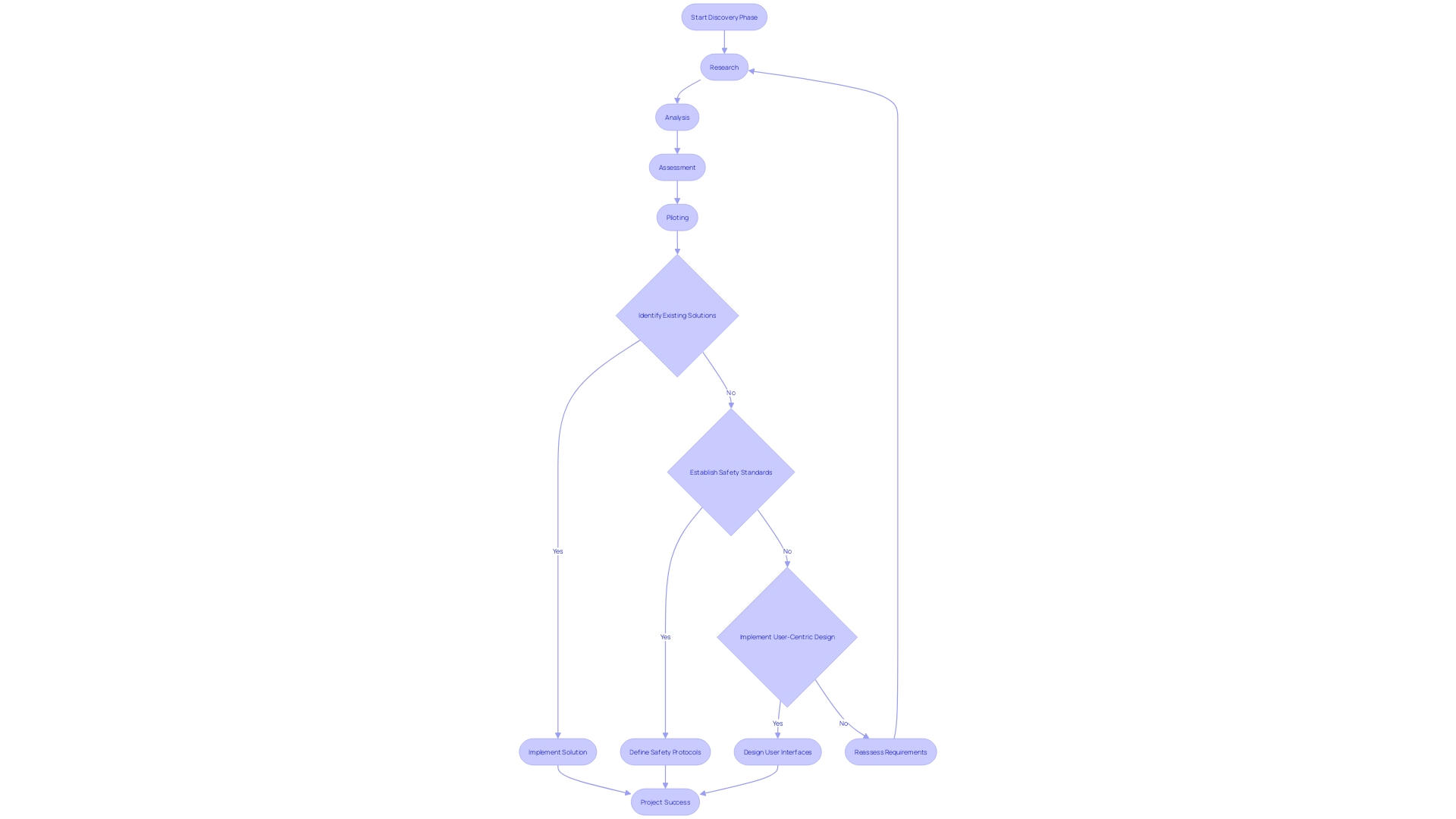Introduction
The Discovery Phase is a crucial strategic period in software development where projects begin to take shape. This article explores the significance of the Discovery Phase, its steps, tools, and techniques, as well as the benefits of conducting a thorough discovery process. It also delves into common challenges faced during this phase and provides best practices for effective discovery.
Through case studies, we witness the profound impact of the Discovery Phase on successful IT projects. By embracing this phase, businesses can navigate the complexities of software development and set themselves up for success in an ever-evolving digital landscape.
What is the Discovery Phase in Software Development?
At the heart of software development lies the Discovery Phase, a strategic period where a project begins to take shape. The phase is marked by an intense focus on researching and analyzing to pinpoint the precise goals, objectives, and limitations of the project. It's a time for brainstorming and refining concepts, where the team delves into market research, identifies the target audience, and drafts an initial blueprint of the software's core features and functionalities.
It's essential during this stage to ensure that the idea has both complexity and originality—'perplexity and burstiness'—so that it fulfills a specific need or resolves a distinct issue. With a well-founded idea, the next step is to chart a comprehensive plan for the development journey, laying out the scope, schedules, and resource allocation. Balancing the 'burstiness' of creative ideas with the specificity of well-defined plans is crucial to forge a clear path forward.
This stage is crucial for research-oriented companies that aim to cycle through many ideas rapidly, allowing for the exploration of a wide array of solutions before narrowing down to the most robust one for productization. During this exploration phase, it's not uncommon to accept some strategic technical debt as part of the process, acknowledging that optimal practices for research and product development can differ significantly. This is often why companies maintain distinct divisions for research and product development.
As the software development process unfolds, from requirements to evolution, the Discovery Phase sets the tone for a lifecycle that includes analysis, design, implementation, and testing. It's this foundation that enables software startups, even under time constraints and resource shortages, to innovate and create software-intensive products that contribute to economic growth and technological advancement.
Importance of the Discovery Phase
The software development process is akin to the meticulous planning and execution that was essential in the construction of the iconic Hoover Dam—one of the largest concrete structures of its era, completed two years ahead of schedule despite extreme challenges. The success of such projects relies heavily on a thorough Discovery Phase, which ensures alignment of stakeholder expectations and a clear definition of project scope. This phase is crucial in identifying the feasibility of the project and confirming that the proposed solutions are in line with business objectives.
It acts as a safeguard against costly revisions and delays later on, similar to how the Hoover Dam's construction required precise planning and the delegation of responsibility to specialists. With the software industry rapidly evolving and a projected $672 billion to be spent on enterprise software by 2024, the Discovery Phase becomes even more vital. It serves as the blueprint for quality software applications, addressing functionality, reliability, usability, and efficiency, and is underpinned by the cyclical nature of software development—from requirements analysis to deployment.
As we embrace new trends like low-code development to meet market demands, the Discovery Phase remains a cornerstone of software excellence, much like the shared responsibility and forward-thinking that underpinned the Hoover Dam's success.

Steps Involved in the Discovery Phase
Initiating a project with a clear understanding of goals, objectives, and constraints sets the foundation for success. This entails pinpointing key stakeholders and setting up effective communication channels to manage expectations from the outset. The discovery phase then delves into a meticulous process of requirements gathering.
By interviewing users, hosting workshops, and conducting thorough research, a comprehensive picture of user needs, technical demands, and business objectives is crafted.
Post-gathering, the analysis and evaluation step comes into play, where the feasibility of varying solutions is weighed against potential risks. It's a strategic move to differentiate between the 'exploration' of diverse solutions and the 'exploitation' of the optimal one – a method that has proven successful in research-driven environments. Defining the scope then becomes the task at hand, pinpointing the necessary features, functionalities, and project deliverables while establishing timelines and allocating resources.
Documentation is the thread that weaves through each phase, ensuring every detail is recorded – from requirement documents to project charters. A case in point is the ongoing development of Aggie Square, a project that has seen its scope defined to include not just research and academic spaces, but also community programming and start-up accommodations, all while embracing a design that nods to the historic brickwork of Sacramento. The project's progression and the strategic use of materials speak to the importance of thoughtful project planning and scope definition.
Understanding that software maintenance can often eclipse initial development costs, it's crucial to anticipate and document maintenance needs early on. This foresight into software lifecycle costs underscores the value of thorough documentation and planning in the discovery phase. An example of this foresight is the emphasis on strategic tech debt during the exploration phase, allowing for a rapid testing of ideas, followed by a concerted effort to refine the best solution during the exploitation phase.
Moreover, the journey of a project from conception to planning should carefully balance innovation with practicality, ensuring it addresses specific needs while providing a clear development roadmap.

Tools and Techniques Used in the Discovery Phase
The Discovery Phase in IT project management is a critical stage where various methodologies are employed to gather insights and establish project foundations. Interviews serve as a gateway to valuable information, allowing project managers to tap into the knowledge of stakeholders, users, and experts. By facilitating workshops, teams can engage in collective dialogue and ideation, setting the stage for clear project objectives and requirements.
Research and analysis are pivotal in painting the bigger picture—understanding market demands, user expectations, and the realm of technological advancements. Prototyping emerges as a powerful tool here, as it brings theoretical concepts into tangible forms, enabling iterative feedback and refinement. And, to keep everything in check, requirement management tools are indispensable for tracking, organizing, and adapting project specifications as the project evolves.
Such methodologies not only streamline the discovery process but also align with modern development philosophies, where the emphasis is on rapid idea validation and strategic tech debt acceptance during the exploration phase, as suggested in industry literature. This iterative, feedback-driven approach is further echoed by industry trends predicting the rise of automated quality control and integrated security practices, underscoring the necessity of objective assessments over subjective judgments.
As AI continues to carve its niche in software development, its role in expediting tasks cannot be understated, yet it's the human developer's expertise that navigates through the more intricate challenges. The Discovery Phase, therefore, is not just about the tools employed but also about the strategic mindset that guides their use, ensuring that every step—from initial concept to final product—contributes to a robust and secure IT ecosystem.

Benefits of Conducting a Thorough Discovery Phase
The Discovery Phase, an integral part of the software development process, offers multifaceted advantages that echo through the entire lifecycle of a project. Here's a closer look at the pivotal benefits:
-
Comprehensive Project Insight: It fosters a shared understanding of project objectives, deliverables, and limitations, ensuring that stakeholders are on the same page, which is crucial for an options-based market or any complex IT system.
-
Risk Mitigation: Early identification of risks, much like analyzing whether code is original or a forked version, allows for timely contingency planning, thus safeguarding against potential setbacks.
-
Economical Efficiency: A well-executed Discovery Phase paves the way for streamlined development, curtailing the need for expensive and time-consuming revisions at later stages, as evidenced by the AI-assisted development journey experienced by numerous companies.
-
Enhanced Team Synergy: This phase promotes a collaborative environment, with alignment on goals and strategies, which is key to making informed decisions and achieving superior project results.
-
Feasibility Validation: It serves as the proving ground for the proposed solution's viability, ensuring alignment with the business's strategic objectives and the realm of technical feasibility.
By integrating the Discovery Phase into the cyclical nature of the software development lifecycle, businesses can significantly improve the quality of their software applications, which encompasses functionality, reliability, usability, and efficiency.
Moreover, as the industry evolves, embracing methodologies like Agile can further enhance transparency and adaptability in project management, leading to increased stakeholder satisfaction and successful project delivery. The iterative approach allows for continuous evaluation and adjustment, which proves to be more effective than rigid technical specifications.
Statistics have shown that software maintenance costs could amount to double the initial development costs over an application's lifetime, underscoring the importance of meticulous planning during the Discovery Phase to avoid expensive overhauls down the line.
Ultimately, the Discovery Phase is not merely a preliminary step; it is a strategic investment in the project's future, enabling businesses to navigate the complex landscape of software development with confidence and precision.

Common Challenges and How to Overcome Them
As the digital landscape continues to evolve, businesses must navigate the complexities of the Discovery Phase with agility and foresight. Take, for example, Nets, a leading provider of digital payment solutions. They faced the intricate task of presenting technical data in an engaging manner, a challenge echoed throughout many IT projects.
To ensure a successful outcome, it is imperative to address common hurdles with strategic solutions.
-
Stakeholder Engagement: Ensuring stakeholder involvement is paramount. A stakeholder analysis can reveal who has influence over a project and their potential impact, allowing for a targeted engagement strategy. By fostering open channels of communication, misalignment is reduced, paving the way for a unified vision for the project.
-
Evolving Requirements: The ebb and flow of project requirements need not be a setback. Instructional Designer Karmela Peček emphasizes the importance of adapting to new information and user feedback. An iterative approach, coupled with a flexible project roadmap, can accommodate changes without derailing progress.
-
Resource Optimization: Resources are often finite, and their effective management is crucial. Drawing from insights on market and user research, one can allocate time and budget strategically, ensuring that every asset is maximized for the Discovery Phase's success.
-
Technical Feasibility: Technical constraints must be acknowledged and addressed. Collaborating with experts to conduct feasibility assessments can help navigate these challenges. As the global biotechnology market continues to grow, the importance of meticulous model development and refinement becomes clear. The right technical collaboration can turn constraints into innovations.
In summary, the Discovery Phase is a critical juncture in project development, demanding a clear understanding of the market, user needs, and technical possibilities. Through proactive stakeholder engagement, flexible planning, resource optimization, and technical collaboration, businesses can surmount these challenges and set the stage for a successful IT project.
Best Practices for Effective Discovery
When embarking on the Discovery Phase of an IT project, it's essential to incorporate strategic practices to ensure a strong foundation for your project's success. Engaging stakeholders is a fundamental first step, as their diverse insights and commitment to the project are invaluable. Take a cue from Nets, a digital payment solutions provider, which emphasizes the importance of presenting technical data in compelling ways that encourage stakeholder participation and knowledge sharing.
Clear objectives need to be established, defining not only what the project aims to achieve but also detailing the tangible benefits it will bring to both users and the business. Reflecting on the product's uniqueness and its stand against competitors can guide these objectives, as demonstrated by how Nets tailored its services to different market needs.
Conducting thorough research is another pillar of the Discovery Phase, requiring a deep dive into market trends, user requirements, and technological capabilities. This aligns with the Agile methodology's principle of welcoming changes based on continuous feedback and adaptation, even if it occurs late in the project timeline.
Collaboration is also crucial, and fostering an environment where team members and stakeholders can openly exchange ideas through workshops and brainstorming sessions can lead to more innovative solutions. This approach resonates with Agile's emphasis on daily collaboration between developers and business executives.
Finally, documentation and review play a critical role in keeping the Discovery Phase transparent and adaptable. All findings, requirements, and decisions must be meticulously recorded and regularly revisited. The dynamic nature of IT project management, which involves real-time adjustments to new challenges, underscores the importance of having comprehensive and falsifiable success criteria that serve as a single source of truth throughout the project lifecycle.
By integrating these best practices into the Discovery Phase, your IT project is positioned for clarity, alignment, and adaptability, ultimately steering it towards a successful outcome.
Case Studies: Successful Discovery Phase Examples
Delving into the Discovery Phase reveals the profound impact it can have on the trajectory of IT projects. Through meticulous research and analysis, this phase lays the groundwork for identifying core strengths and uncovering areas of potential risk. For instance, consider the case of a healthcare trust, where a detailed initial assessment of digital technology requests led to the discovery of existing solutions within the organization, significantly streamlining their approach to adopting new technologies.
Similarly, an examination of the wildfire risk in California's utilities sector, based on extensive research and expert interviews, underscored the importance of robust safety standards for investor-owned electrical companies. This parallels the need for stringent protocols in IT projects to mitigate risks and ensure compliance. Meanwhile, Te Kāhui Raraunga Charitable Trust's pioneering data storage infrastructure, Te Pā Tūwatawata, demonstrates the benefits of piloting innovative solutions before widespread implementation.
The success of this pilot phase, rooted in the community's unique needs, signifies the merit of a well-conducted Discovery Phase. Additionally, Nets' approach to presenting complex technical data in an accessible format highlights the value of continuous iteration and stakeholder feedback during the Discovery Phase. This iterative process fosters adaptability and user-centric design, leading to more effective and engaging digital payment solutions.
Lastly, the shift from an outstaffing model to a comprehensive outsourcing service provider, as seen in the journey of a new CTO, illustrates the transformative potential of the Discovery Phase in setting a clear vision and aligning expectations for project success.

Conclusion
The Discovery Phase in software development is a crucial strategic period where projects take shape. It ensures alignment of stakeholder expectations, confirms project feasibility, and identifies potential risks. Thorough documentation and planning balance innovation with practicality.
Various tools and techniques streamline the Discovery Phase, such as interviews, workshops, research, prototyping, and requirement management tools. While AI expedites tasks, human expertise navigates intricate challenges.
Conducting a thorough Discovery Phase offers multifaceted benefits. It fosters comprehensive project insight, mitigates risks, improves efficiency, enhances team synergy, and validates feasibility.
Best practices, like engaging stakeholders, establishing clear objectives, conducting thorough research, fostering collaboration, and maintaining comprehensive documentation, ensure a strong foundation for project success.
In conclusion, the Discovery Phase is a strategic investment in project success. By embracing this phase and following best practices, businesses navigate complexities and set themselves up for success in the digital landscape.





